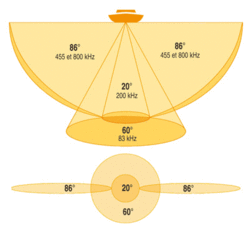HUMMINBIRD Technology
Details
Units with this system offer several features :

- sounder classical (vertical sounding)
- survey side (Side Imaging)
- GPS plotter / card reader

Two side beams sweep the sides, with a theoretical range of 110 m each. Unlike conventional cone-shaped beams, the beams Side Imaging are very thin in their horizontal dimension, but very wide in the vertical dimension. They therefore behave like acoustic curtains that you walk about at right angles to each side of the boat. To obtain a good side image, it is important that the boat is constantly moving at high speeds (between 1 and 3 knots), preferably in a straight line to avoid distortions. The strong echoes are displayed in clear, those of medium intensity in neutral tone, and those of low intensity dark. The images back, hard bottoms, objects well separated from the bottom return stronger echoes that appear in the clear. The beams that go down or soft bottoms appear in dark. Moreover, if a high obstacle (echo clear) intercepts the beam, it creates behind a gray area which receives no waves, so do not return. This area appears dark. Larger if the barrier is important, it looks like a shadow, like an object subjected to a raking light.
The Side Imaging shows the two sides vertically, the bottom appearing from top to bottom on the screen as opposed to a classical representation system. The definition of the image depends, not on the number of vertical pixels, but the number of horizontal pixels.
If we consider that we probe distances (up to 220 meters in total), this system is very demanding in pixels, and a small screen is a handicap. We can work around this problem by choosing to display on the screen one side, multiplying by two the definition.

The Side Imaging shows the two sides vertically, the bottom appearing from top to bottom on the screen as opposed to a classical representation system. The definition of the image depends, not on the number of vertical pixels, but the number of horizontal pixels.
If we consider that we probe distances (up to 220 meters in total), this system is very demanding in pixels, and a small screen is a handicap. We can work around this problem by choosing to display on the screen one side, multiplying by two the definition.

